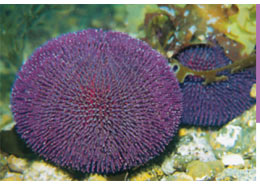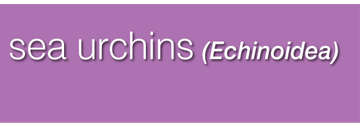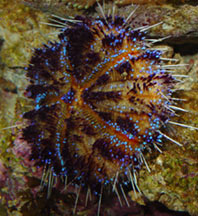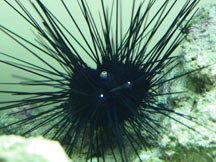Michael Paletta - Guest Author
 |
 |
|
There are over 800 different species of
sea urchins varying greatly in appearance, ranging in size from less than an inch to over a foot |
across in an assortment of shapes and colors. Unlike sea cucumbers, which look benign and helpless, sea urchins look quite formidable with their extensive network of spines.
 Most urchins have two distinct types of spines: large primary spines and smaller secondary spines. These spines are attached to a series of calcareous plates or skeletal ossicles by a structure very similar to a ball and socket joint and move as the plates move. A sheath surrounding the sockets moves the joints and gives the spines a great deal of flexibility. As if the spines were not formidable enough, some species of urchin also possess poison that they eject through their spines. Needless to say, for the most part these poisonous urchins should not be kept.
Most urchins have two distinct types of spines: large primary spines and smaller secondary spines. These spines are attached to a series of calcareous plates or skeletal ossicles by a structure very similar to a ball and socket joint and move as the plates move. A sheath surrounding the sockets moves the joints and gives the spines a great deal of flexibility. As if the spines were not formidable enough, some species of urchin also possess poison that they eject through their spines. Needless to say, for the most part these poisonous urchins should not be kept.
Like sea cucumbers, sea urchins play a vital role on the reef by keeping algae population in check. Most species are herbivores, but there are species that are detrivores or scavengers and a few predatory species that feed on corals and other sessile invertebrates. Sea urchins feed on virtually all types of algae including calcareous algae (e.g. coralline algae). Hence, if calcareous algae are desirable, the number of urchins kept in a system should be limited to allow calcareous algae to grow. Sea Urchins have a healthy appetite and their steady consumption of calcareous algae results in the production of large quantities of calcareous sand.
 Though they are most active at night, urchins seem to eat constantly and are quite indiscriminate in terms of what they eat. When keeping these animals, make sure that adequate food is available since they will rapidly consume any and all algae they come across including beautiful and desirable coralline algae. If kept in too large of a number or if there is not adequate amounts of algae, they will render an aquarium completely free of any and all algae as well as any small sessile microfauna that they might come across.
Though they are most active at night, urchins seem to eat constantly and are quite indiscriminate in terms of what they eat. When keeping these animals, make sure that adequate food is available since they will rapidly consume any and all algae they come across including beautiful and desirable coralline algae. If kept in too large of a number or if there is not adequate amounts of algae, they will render an aquarium completely free of any and all algae as well as any small sessile microfauna that they might come across.
Therefore, only one urchin should be kept per each 50-75 gallon aquarium. More can be added if an aquarium becomes overgrown with undesirable algae, but the extra urchins should be removed once the algae are under control. Sea urchins perform a valuable function on the reef that can be translated and put to good use in a reef aquarium. It should be noted though, that urchins have a very strong tendency to knock over anything that is not solidly in place so this should also be taken into account before adding urchins.
Part 7 of 8. Continue reading:
Part 1
Intro |
Part 2
Unique Chararcteristics |
Part 3
Unique Defense Chararcteristics |
Part 4
Sea Stars (Asteroidea) |
Part 5
Brittle & Serpent Starfish (Ophiuroidea) |
Part 6
Sea Cucumbers (Holothuroidea) |
Part 7
Sea Urchins (Echinoidea) |
Part 8
Feather Stars (Crinoidea) |
Biography
Michael Paletta is the author of two books, "The Modern Marine Aquarium" and "Ultimate Reefs," and has acted as a consultant with the National Aquarium in Baltimore and the Pittsburgh Zoo Aquarium. |






